
This page created 26 December 2002, and last modified: 26 December 2015 (Kovács reference added)

The following units and officers along with their men are listed as being under the command of the Dux Valeriae ripensis (i.e. the "Duke of riverine Valeria", corresponding to modern central Hungary; the numbers in front of the names refer to Ingo Maier's numbering scheme):
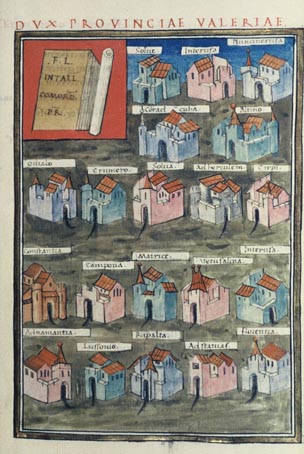 Above: Frontpiece from the Bodleian manuscript, O. The stations depicted are: Solue, Intercisa, Nuncinercisa, Conradcuha, Altino, Odiabo, Crumero, Solua, Ad Herculem, Cirpi, Constantia, Campona, Matrice, Vetusalina, Intercisa, Adnamantia, Lussonio, Ripalta, Ad Statuas, Florentia.
|
143.2 Cuneus equitum scutatorum, at Solue |
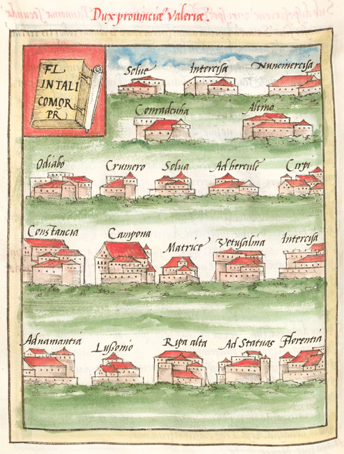 Above: Frontpiece from the Munich manuscript, M. The imagery is typical of the mid-16th century Germany.
|
Note that Seeck amended (OC. XXXIII.56) the Praefectus militum secundae adiutricis to read Praefectus legionis secundae adiutricis; this reading is apparently found in the Bodleian manuscript, O, but not in the Parisian (P), Munich (M), or Trento (T) manuscripts. He also added (OC.XXXIII.52) a "quintae" between cohortis and partis superioris for the detachment of Legio II Adiutrix stationed at Aliscae, and bracketed (OC.XXXIII.54) the "tertia" in the attachment of Legio II Adiutrix stationed at Acinco for deletion. I do not know why he thought these amendments were desirable or necessary, but presumably had something to do with his thesis that the Notitia was an "official" document, and should be free from "irregularities".
Unlike all the other provinces mentioned in the Notitia, Valeria ripensis does not appear to have a civil governor. The province is listed (85/6.42) as being one of twelve provinces in the west that has an associated Duke (Dux), but there is no corresponding entry for the province under the list of the provinces controlled by the Italian Praetorian Prefect, who is in charge of the civilian Diocese of Illyricum, and which would otherwise cover the geographical area concerned. The Duke himself is likewise listed (98/9.13) as being subordinate to the Magister Peditum, but there are no civilian officers (e.g. Procurators of weaving houses or mints) listed as being in the province. One of the western fabricae (military manufacturing arsenals) is listed (107.16) as being Acincensis scutarie, i.e. located at Acincum (Aquincum, modern Óbuda in Budapest), and manufacturing shields; but it comes under the control of the western Magister Officiorum, who is not a civilian officer.
The Auxilia insidiatorum (143.28) would appear to be the Insidatores listed (102/5.159) under the Magister Equitum's Gallic command; since they are not listed under the Magister Peditum's infantry roster, they are otherwise unattested. There is an outside chance the Auxilia Ursaren[s]ia (143.25) may similarly be the Gallic command's Cursarienses iuniores (102/5.156). although this is not particularly likely, given entry 143.25 seems to have been amended after the Notitia's original compilation (see further below, regarding "nunc").
The men under the Praefectus legionis primae adiutricis (143.29) are clearly the Legio I Adiutrix Pia Fedelis bis constans, and those under the six different listings of a Praefectus legionis secundae adiutricis (143.30-35) are the Legio II Adiutrix Pia Fedilis. The name and number of the last legionary detachment (143.43) is not given, though it is given a station: Transiacinco (i.e. opposite Acincum). It may simply be another detachment of one of the other two, no doubt the first, since while it is listed above as being in part (five cohorts' worth) stationed at Bregetione (i.e. Brigetio, the Komárom-Szőny of modern Hungary), the whereabouts of the other part is not otherwise mentioned. This legion was still stationed in Brigetio in the mid 5th century, well after the Nottia was last modified. Note, however, that the building activities of a detachment from Legio I Martiorum is attested epigraphically (RIU 771 = AE 1999, 1264; RIU 804; AE 2000, 1223, image here) in Valeria from the early 370s; in particular, the latter two of these records come from Visegrád (i.e. Ponte Navata, ca. 20 km north of Aquincum), so the identity of the 143.43 cannot be conclusively established as being a second detachment of Legio I Adiutrix.
Like some other Danubian provinces, the legions in Valeria are split between up-river ("superioris") and down-river ("inferioris") sections; however, unlike those in neighbouring Pannonia, those in Valeria appear to be intact (assuming the un-named detachment at Transiacinco is the inferioris part of Legio I Adiutrix, that is). Nonetheless, some units were withdrawn from Valeria before the Notitia was compiled: inscriptional evidence (RIU 5, 1205, image here) attests the presence of a N EQQ SCUT (numerus equitum scutariorum) at Intercisa (modern Dunaújváros in central Hungary), but not in the Notitia, and likewise (CIL 3,3370 = RIU 6,1365, image here): a militum Histricorum from Aquincum.
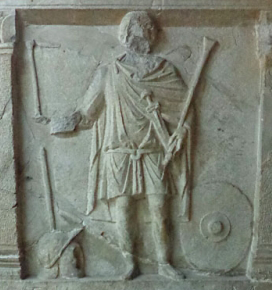
|
Note that several of the entries in the troop list for the province are amended with an entry starting nunc ("now at"), which clearly derives from after the time the list was first compiled, e.g. the Cuneus equitum Constantianorum, Lusiono, nunc Intercisa. Exactly when these amendments were made is unknown, however.
There is an infantry unit called the Acincenses listed (102/5.153) under the Magister Equitum's Gallic command that is not in the Magister Peditum's infantry roster, and whose name clearly derives from Aquincum. This may ultimately be derived from either Legio I or II Adiutrix, probably via the command of the Dux Mogontiacensis, which lists a Praefectus militum Acincensium (156/8.12); however, a reposting of the Auxilia vigilum (143.26) is also a possibility. To the left is the grave stele of one Aurelius Surus, found in Istanbul, and now in the Istanbul Archaeological Museum; he is described in the accompanying inscription (AE 1976, 642) as being a former bucinator (trumpeter) in Legio I Adiutrix. The stele most likely dates from the 2nd decade of the 3rd century, since the legion was active in Byzantium during this time - the name "Surus" implies a Syrian origin; many soldiers named "Aurelius Surus" are known from grave inscriptions all over the empire. His shield is both small and rounded, as befits a non-rank-and-filer; however, this is also the period when such shields seem to have been used more widely by legionaries, such as by lanciarii, so not too much need be read into this. The shield shows a raised boss plus a wider band or flange, as seen with many patterns in the Notitia, and no discernible decoration. Unfortunately, none of the patterns in the Notitia featuring such a boss and surrounding band belong to legionary units entitled Prima: it would seem no link can be drawn between this shield and any of the Notitia patterns. |
The Praefectus classis Histricae (143.36) is in charge of a detachment of the Danubian fleet; other detachments of the same fleet are listed under the Dux Provinciae Pannoniae secundae ripariensis et Saviae, the Dux Moesiae primae, the Dux Daciae ripensis, and presumably the Dux Scythiae (whose fleet detachment is not named) and the Dux Pannoniae primae et Norici ripensis, whose fleet detachments are named after their shore stations, and not after the river.
One of only five leaves known to remain of the Cambridge manuscript, "C", and which now resides in the Fitzwilliam Museum, Cambridge, England, happens to cover the complete Dux Valeriae section. This is the only military section included in any of the five leaves; the recto, showing unit locations in the form of hexagonal forts, is shown below left (the verso is the textual entries), together with the corresponding section from the Froben edition, B (below right).
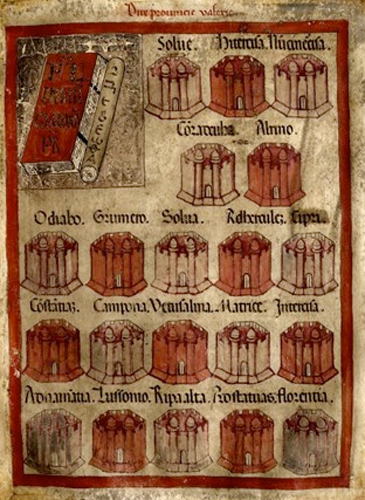
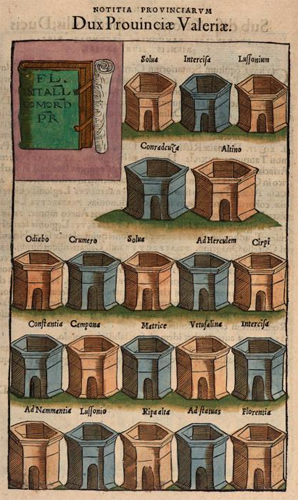
As can be seen, although the manuscripts vary greatly in terms of their picture styles, although C, B, and W all show hexagonal forts (note that in C, the positions of the forts named Matrice and Vetusalina are reversed compared to the other manuscripts). The hexagonal style is believed to have been present in the lost Codex Spirensis from which all the extent manuscript copies are ultimately derived. Unlike W, those of B and C have the bottom portion of walls battered (sloped); unlike W, those of B and C also have each fort with but a single gate, and alternate the colours of the forts (the facings of the pictures in B are reversed, being printed). B however, shows no towers, while W and C give each fort two; likewise, B shows no battlements, while both C and W do.
Note that the "name" of the fort on the right of the top row is "Nuncinercisa" (sic, meaning "now at Intercisa") in all the manuscript copies, but "Lussonio" in the Froben edition. That the Froben edition's name makes sense, while the manuscripts' shared label does not, has been taken as evidence of editorial intervention, but it might also be evidence for a superior textual transmission (via the lost Basel manuscript, Bf).
1. Ingo Maier; "Appendix 4: Numeration of the new edition of the compilation 'notitia dignitatum' (Cnd)"; last accessed 7 December 2015. See also for here for numbering examples. Return
2. Seeck, Otto (Ed.); "Notitia Dignitatum accedunt Notitia urbis Constantinopolitanae et Latercula prouinciarum", Weidmann, Berlin, 1876; available here (last accessed 26 October 2015). Return
3. Kovács, Péter; "The late Roman army in Pannonia"; Acta Ant. Hung. 44 (2004), pp 115-122; available here (last accessed 12 December 2015). Return
4. Maier, Ingo; "Speyer codex (Codex Spirensis) and Speyer miscellany (collectio Spirensis)"; last accessed 20 December 2015. Return

Return to the Notitia index page.